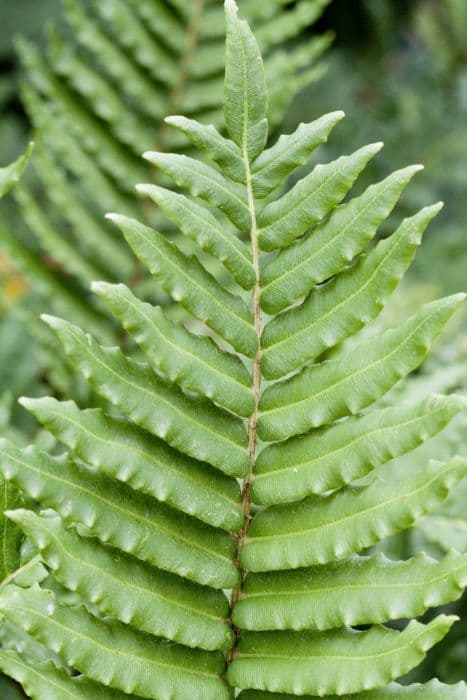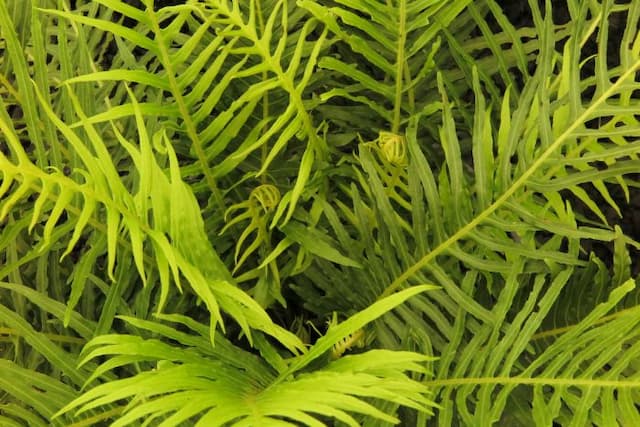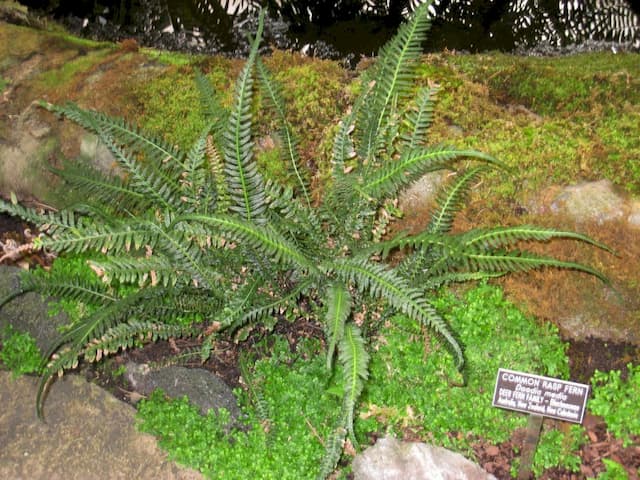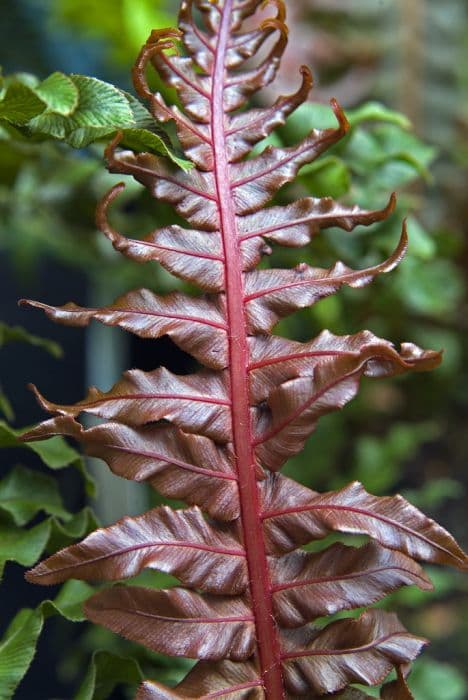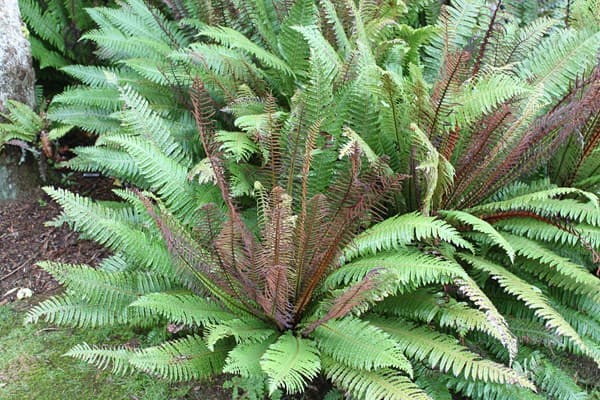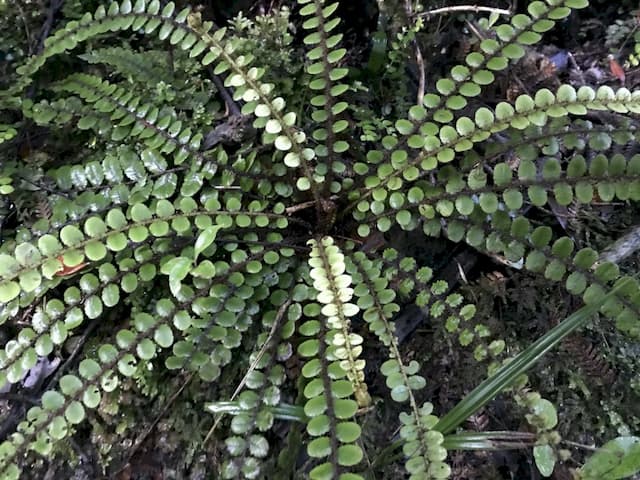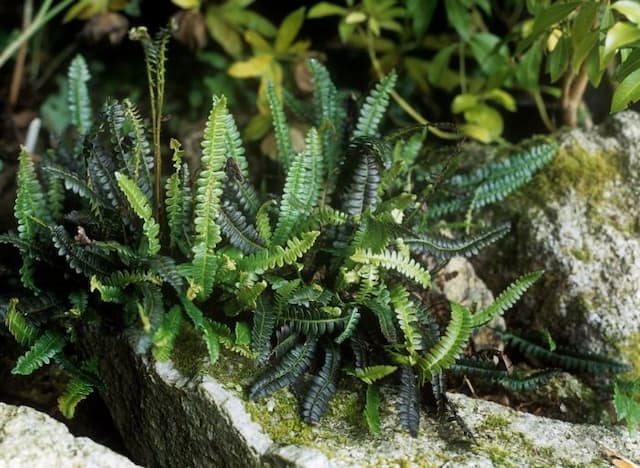Brazilian Dwarf Tree Fern Blechnum brasiliense

ABOUT
The plant known as Brazilian tree fern boasts an attractive clump-forming habit with striking foliage. The leaves, or fronds, are the most prominent feature, emerging a bright, glossy red before gradually maturing to a deep green. The young, colorful fronds create a beautiful contrast against the older, green ones. The fronds are pinnate, which means they have a central stem with smaller leaflets arranged on either side, and these can vary in texture from smooth to slightly leathery. As the plant matures, it develops a short, trunk-like base from which the fronds arch gracefully. The overall shape of the Brazilian tree fern is elegant and can add an ornamental touch to garden spaces or indoor settings where they're grown, with their lush, feathery foliage contributing to a tropical atmosphere.
About this plant
 Names
NamesFamily
Blechnaceae.
Synonyms
Brazilian Dwarf Tree Fern, Red Dwarf Tree Fern, Almecega Fern.
Common names
Blechnum mochaenum, Lomaria collina, Lomaria discolor, Lomaria brasiliense, Blechnum collinum, Struthiopteris brasiliensis, Blechnum attenuatum, Blechnum corcovadense, Blechnum ensiforme, Blechnum schiedeanum, Blechnum serrulatum, Blechnum subcordatum, Blechnum volubile, Lomaria schiedeana.
 Toxicity
ToxicityTo humans
Red Brazilian tree fern is not commonly known to be toxic to humans. However, as with many plants, it is generally advisable not to ingest parts of this fern as they are not intended for human consumption and there could be potential risks of gastrointestinal discomfort or allergic reactions in sensitive individuals.
To pets
Red Brazilian tree fern is not widely recognized as toxic to pets. Nevertheless, it is usually recommended to prevent pets from eating plants not meant for their consumption. Ingestion of plant parts may lead to stomach upset or an allergic reaction in some pets. If you suspect your pet has eaten this fern and is showing adverse symptoms, it's best to consult a veterinarian.
 Characteristics
CharacteristicsLife cycle
Perennials
Foliage type
Evergreen
Color of leaves
Green
Height
2-3 feet (60-90 cm)
Spread
2-3 feet (60-90 cm)
Plant type
Fern
Hardiness zones
9
Native area
South America
Benefits
 General Benefits
General Benefits- Landscape Ornamentation: Blechnum brasiliense, commonly known as Brazilian Tree Fern, adds tropical aesthetic appeal to gardens and landscapes due to its attractive foliage and structural form.
- Shade Tolerance: The Brazilian Tree Fern thrives in shaded areas, making it an ideal choice for understory planting in woodland gardens or shaded borders.
- Erosion Control: With its dense root system, the Brazilian Tree Fern can help stabilize soil and prevent erosion on sloped terrain or in areas with loose soil.
- Habitat Provision: As a native plant, it can provide suitable habitat and food source for native fauna, including insects and birds that may require specific plants for their survival.
- Cultural Significance: In certain cultures or regions, the Brazilian Tree Fern may have traditional significance and be used in ceremonies, as well as ornamental displays.
- Low Maintenance: Once established, the Brazilian Tree Fern is relatively low maintenance, requiring minimal care beyond basic watering and protection from extreme temperatures.
- Drought Resistance: Able to withstand periods of dryness once mature, making it an appropriate choice for gardens in climates with intermittent rainfall.
 Medical Properties
Medical Properties- Anti-inflammatory: Blechnum brasiliense is traditionally used for its anti-inflammatory properties.
- Analgesic: It may possess pain-relieving qualities.
- Antipyretic: The plant is sometimes used to reduce fever.
- Wound healing: There are claims of its use in promoting the healing of wounds.
 Air-purifying Qualities
Air-purifying QualitiesThis plant is not specifically known for air purifying qualities.
 Other Uses
Other Uses- The fronds of the Red Brazilian Tree Fern, when young, can be used as a natural packing material for transporting delicate items due to their soft texture.
- Dried and powdered fronds of the Red Brazilian Tree Fern can be mixed with other materials to create a natural dye for textiles.
- The plant can be cultivated as an ornamental species in gardens and parks for its attractive foliage and tropical appearance.
- In some cultures, the fibrous roots of the Red Brazilian Tree Fern are used in the making of handicrafts or as a component in basket weaving.
- The plant serves as a host for various butterfly species, thus contributing to biodiversity and the life cycle of these insects.
- The Red Brazilian Tree Fern can be used in education for studying the growth patterns and lifecycle of ferns in botany classes.
- The sturdy fronds may be used in creating sustainable, biodegradable temporary shelters for small wildlife or as part of naturalistic landscaping.
- Culinary artists might use the visually striking fronds of the Red Brazilian Tree Fern as a natural garnish for exotic dishes.
- In sustainable living practices, the fronds might be used to thatch roofs for small outdoor structures such as garden sheds.
- Large fronds can be laid over garden beds as a form of natural mulch to retain moisture and suppress weed growth.
Interesting Facts
 Feng Shui
Feng ShuiThe Brazilian tree fern is not used in Feng Shui practice.
 Zodiac Sign Compitability
Zodiac Sign CompitabilityThe Brazilian tree fern is not used in astrology practice.
 Plant Symbolism
Plant Symbolism- Resilience: Blechnum brasiliense, commonly known as the Brazilian tree fern, is symbolic of resilience due to its ability to thrive in diverse conditions and adapt to different environments.
- Growth and Aspiration: As a fern that reaches towards the light in forest understories, it represents the idea of growth and aspiration toward achieving one's potential.
- Endurance: The Brazilian tree fern's sturdy fronds that persist even in challenging conditions are emblematic of endurance and the capability to withstand adversity.
 Water
WaterThe Brazilian Tree Fern should be watered consistently to maintain moist soil, making sure to avoid waterlogged conditions. They do well with a deep watering once a week, which would typically translate to about 1/4 to 1/2 gallon for smaller potted specimens and up to 2-3 gallons for larger plants in big containers or outdoor settings. Adjust watering frequency based on temperature and humidity, watering more often during hot, dry periods and reducing frequency in cooler, overcast conditions. Always water directly at the soil level, avoiding wetting the fronds to reduce the risk of fungal diseases.
 Light
LightThe Brazilian Tree Fern thrives in bright, indirect sunlight. A spot that mimics the plant's natural habitat, such as east or north-facing locations that receive morning light or filtered sunlight throughout the day, would be ideal. Direct afternoon sunlight should be avoided, as it can scorch the fronds. Place the plant in an area where it can also benefit from some dappled shade, especially during the harshest part of the day.
 Temperature
TemperatureThe Brazilian Tree Fern prefers warm temperatures and cannot tolerate cold. The ideal temperature range for this plant is between 60°F and 80°F. It should not be exposed to temperatures below 50°F, as cold conditions can cause damage to the fronds. In areas with cooler winters, it is important to protect the plant from frost and to bring it indoors if it is kept outside during the warmer months.
 Pruning
PruningPruning the Brazilian Tree Fern should be done to remove any dead or damaged fronds to maintain plant health and appearance. This maintenance can be performed as needed throughout the year, but it is best to prune in early spring before new growth begins. Occasional thinning of old fronds also encourages fresh growth and allows light to reach the interior of the plant.
 Cleaning
CleaningAs needed
 Soil
SoilThe Brazilian tree fern thrives best in a well-draining soil mix that is rich in organic matter. An ideal soil recipe can consist of equal parts peat, pine bark, and perlite or sand. Adjust the soil pH to be slightly acidic, around 5.5 to 6.0, for optimal growth.
 Repotting
RepottingThe Brazilian tree fern should be repotted every 2 to 3 years to refresh the soil and accommodate its growing root system. Repotting is best done in the spring or early summer when the plant is in its active growth phase.
 Humidity & Misting
Humidity & MistingThe Brazilian tree fern prefers a high humidity environment, ideally between 60% to 80%. Maintaining sufficient humidity is crucial for the plant's fronds to remain lush and healthy, mimicking its native tropical habitat.
 Suitable locations
Suitable locationsIndoor
Provide bright, indirect light and maintain high humidity.
Outdoor
Grow in partial shade, shelter from cold winds.
Hardiness zone
9-11 USDA
 Life cycle
Life cycleBlechnum brasiliense, also known as Brazilian Dwarf Tree Fern, begins its life cycle as a spore, released from mature ferns, which, upon finding a suitable moist and shady environment, germinates to form a small, heart-shaped gametophyte. This gametophyte then develops sex organs, producing both sperm and eggs, which upon fertilization, grow into a young sporophyte - the recognizable fern plant. The young sporophyte develops a rhizome from which fronds emerge, first as curled structures known as fiddleheads, which unfurl into large, pinnate leaves. As the fern matures, these fronds develop sori on their undersides, which are clusters of spore-producing structures called sporangia. Once the sporangia release their spores, the life cycle can begin anew if the spores find suitable conditions to grow. Over its lifetime, which can span several years, the Brazilian Dwarf Tree Fern increases in size and can form a woody trunk, reproducing multiple times through its spore-based life cycle.
 Propogation
PropogationPropogation time
Spring-Early Summer
For the Dwarf Brazilian Tree Fern, division is a widely practiced method of propagation. The best time to propagate is during the spring when the plant is emerging from its dormant period and beginning a phase of active growth. To propagate via division, you carefully remove the plant from its pot and gently separate the rhizomes, ensuring that each section has roots and at least one frond. These sections are then potted into individual containers filled with a well-draining potting mix and kept in a warm, humid environment to encourage root development. It is crucial to maintain consistent moisture without making the soil waterlogged and to provide light but not direct sunlight until new growth appears, indicating the division has been successful.
![Dwarf Brazilian tree fern [Eruption]](/_next/image?url=https%3A%2F%2Fplants-admin.emdemapps.com%2Fimages%2Fplants%2F%2Fimages%2F604b5592bbce2.png&w=640&q=75)
